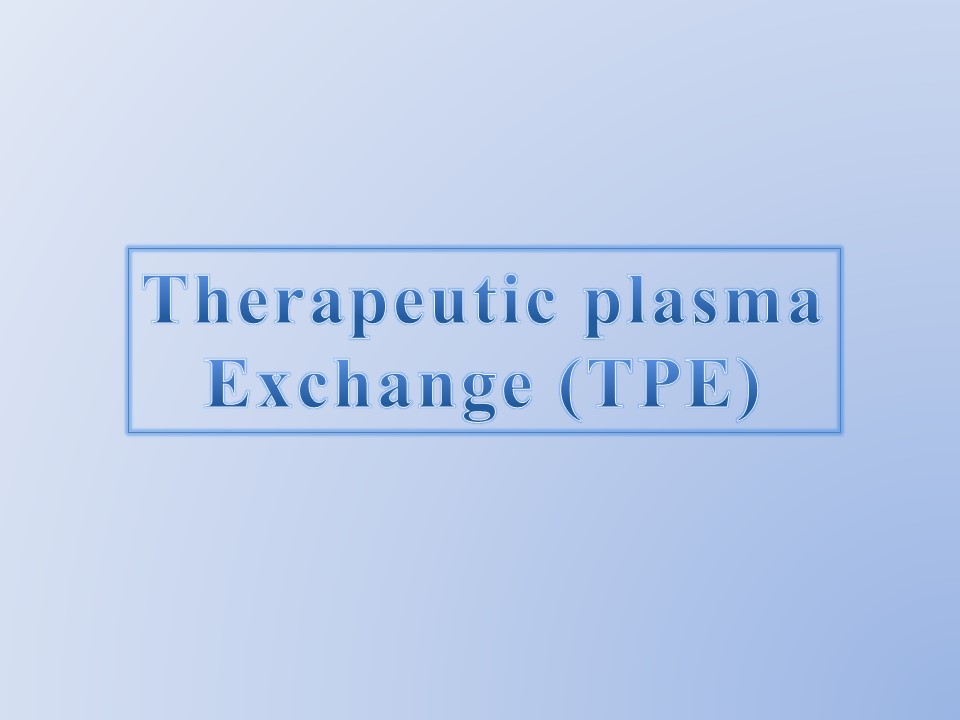Therapeutic Plasma Exchange (TPE) - PowerPoint PPT Presentation
Title:
Therapeutic Plasma Exchange (TPE)
Description:
Therapeutic Plasma Exchange (TPE) is a procedure where a patient's blood is filtered through an apheresis machine, with red blood cells reinfused and replacement fluid like plasma or albumin added to the patient. This presentation gives an overview on "Therapeutic Plasma E xchange". For more information please contact us: 9779030507. – PowerPoint PPT presentation
Number of Views:1
Title: Therapeutic Plasma Exchange (TPE)
1
Therapeutic plasma Exchange (TPE)
2
Therapeutic plasma Exchange
- A procedure in which blood of the patient is
passed through a medical device which separates
out plasma from other components of blood, the
plasma is removed and replaced with a replacement
solution such as colloid solution (e.g., albumin
and/or plasma) or combination of
crystalloid/colloid solution. - Plasmapheresis Separation of plasma from whole
blood using an automated cell separator and
returning back the remaining components.
3
(No Transcript)
4
(No Transcript)
5
Categories for Therapeutic Apheresis Indications
- TA is standard and acceptable first line therapy,
but not always mandatory. - TA is generally accepted but considered to be
supportive or adjunctive to other more definitive
treatment or when first line measures fail or
poorly tolerated. - Existing evidence insufficient either to
establish efficacy or TA or to clarify the risk
benefit ratio associated with TA. - Controlled Trials have not shown benefit or
anecdotal reports are discouraging. TA is done
only in the context of an IRB- approved research
protocol.
Journal of Clinical Apheresis 22 95 (2007)
6
Colloid replacement fluids for TPE
Fluid Advantages Disadvantages
5 Albumin Viral safety Convenience Reactions rare High cost Most proteins not replaced
Fresh Frozen plasma (FFP)/ Single-donor plasma All proteins replaced Citrate reaction Urticaria Infection possible
7
- TPE removes the anti-ADAMTS 13 autoantiantibody
- Pre- and post-procedure hemogram, electrolytes
(including ionized Ca) serum LDH and platelet
count - Daily TPE 1 to 1.5 times plasma volume was
exchanged using group specific FFP. - In view of anemia five units of PRBC were
transfused during the procedures. - 1 amp (10ml) of 10 calcium gluconate for every
1000ml of plasma exchanged - Received a total of 12 procedures
- No procedural complications except for two
instances when patient developed mild allergic
reaction - Platelet count started to increase after 10th
cycle of plasma exchange with peripheral smear
showing less number of schistocytes. - PLT count remained more than 150X 103/ µL , serum
LDH was near normal and no schistocytes were
visible on peripheral blood smear.
8
Plasma Hb 180 mg/L 20
mg/L
9
Serial changes in platelet counts and hemoglobin
in patient during her hospital stay after
receiving 12 cycles of plasma exchange and
steroids (5 units of PRBC transfusion were given
to correct anemia)
10
Serial changes in Serum LDH in patient during 12
cycles of TPE
11
THANK YOU































